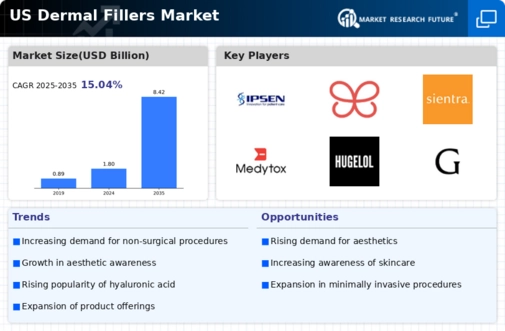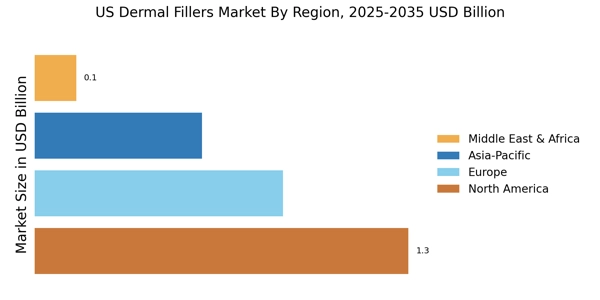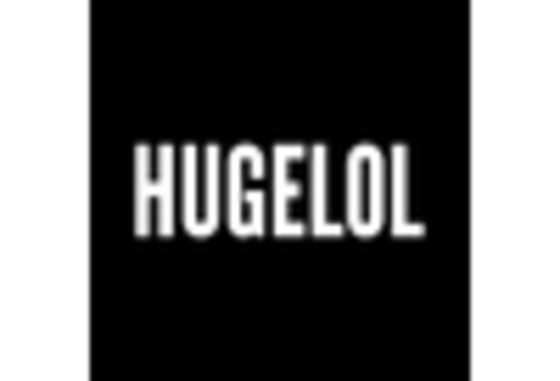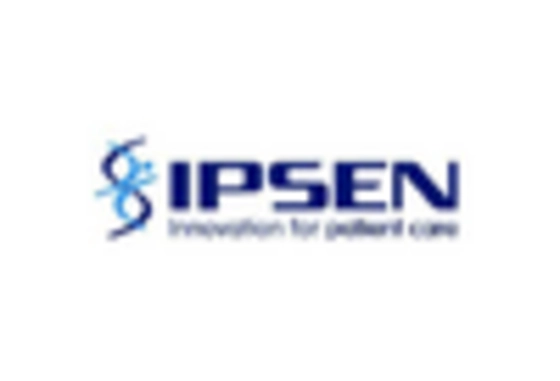Influence of Aging Population
The aging population in the United States significantly impacts the dermal fillers market, as older adults increasingly seek solutions to combat signs of aging. With a growing number of individuals aged 50 and above, the demand for dermal fillers is expected to rise. This demographic shift is accompanied by a heightened awareness of aesthetic treatments, leading to a greater willingness to invest in cosmetic procedures. Reports indicate that the market for dermal fillers is likely to expand by approximately 8% annually, driven by this aging population. As individuals prioritize maintaining a youthful appearance, the dermal fillers market is poised for growth, reflecting the changing attitudes towards aging and beauty.
Expansion of Product Offerings
The dermal fillers market is characterized by an expansion of product offerings, which plays a crucial role in attracting a diverse consumer base. Manufacturers are increasingly introducing innovative formulations that cater to various skin types and aesthetic goals. For instance, the introduction of hyaluronic acid-based fillers has gained popularity due to their biocompatibility and effectiveness. This diversification allows practitioners to tailor treatments to individual needs, enhancing patient satisfaction. Additionally, the market is witnessing a rise in combination therapies, where dermal fillers are used alongside other aesthetic procedures. This trend not only broadens the scope of treatment options but also contributes to the overall growth of the dermal fillers market, as consumers seek comprehensive solutions for their aesthetic concerns.
Rising Awareness of Non-Invasive Procedures
There is a marked increase in awareness regarding non-invasive procedures, which significantly benefits the dermal fillers market. As consumers become more informed about the advantages of non-surgical options, they are more inclined to consider dermal fillers as a viable alternative to surgical interventions. Educational campaigns and marketing efforts by practitioners have played a pivotal role in demystifying these procedures, leading to a broader acceptance among potential clients. The convenience and minimal recovery time associated with dermal fillers further enhance their appeal. Consequently, the dermal fillers market is likely to experience continued growth as more individuals opt for non-invasive solutions to enhance their appearance.
Increasing Demand for Aesthetic Enhancements
the dermal fillers market is experiencing a significant increase in demand as consumers increasingly seek aesthetic enhancements. This trend is driven by a growing societal acceptance of cosmetic procedures, particularly among younger demographics. According to recent data, the market is projected to reach approximately $5 billion by 2026, reflecting a compound annual growth rate (CAGR) of around 10%. The desire for non-invasive solutions that offer immediate results without significant downtime contributes to this growth. Furthermore, the rise in disposable income among consumers allows for greater expenditure on personal appearance, thereby propelling the dermal fillers market forward. As individuals prioritize self-care and beauty, the industry is likely to witness sustained growth, indicating a robust future for aesthetic enhancements.
Technological Innovations in Treatment Techniques
Technological innovations in treatment techniques are transforming the dermal fillers market, enhancing both efficacy and safety. Advances in injection techniques, such as micro-cannulas, reduce the risk of complications and improve patient comfort. Additionally, the development of smart fillers that respond to the body's natural processes is gaining traction. These innovations not only improve the overall experience for patients but also expand the range of applications for dermal fillers. As practitioners adopt these advanced techniques, the dermal fillers market is expected to grow, driven by increased consumer confidence in the safety and effectiveness of these treatments. The ongoing evolution of technology in this field suggests a promising future for the industry.


















Leave a Comment